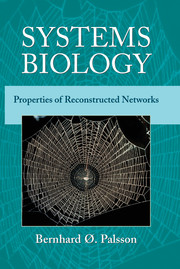Book contents
- Frontmatter
- Contents
- Preface
- 1 Introduction
- 2 Basic Concepts in Systems Biology
- PART I RECONSTRUCTION OF BIOCHEMICAL NETWORKS
- PART II MATHEMATICAL REPRESENTATION OF RECONSTRUCTED NETWORKS
- PART III CAPABILITIES OF RECONSTRUCTED NETWORKS
- 12 Dual Causality
- 13 Properties of Solution Spaces
- 14 Sampling Solution Spaces
- 15 Finding Functional States
- 16 Parametric Sensitivity
- 17 Epilogue
- APPENDIX A Nomenclature and Abbreviations
- APPENDIX B E. coli Core Metabolic Network
- Bibliography
- Index
12 - Dual Causality
from PART III - CAPABILITIES OF RECONSTRUCTED NETWORKS
Published online by Cambridge University Press: 05 September 2012
- Frontmatter
- Contents
- Preface
- 1 Introduction
- 2 Basic Concepts in Systems Biology
- PART I RECONSTRUCTION OF BIOCHEMICAL NETWORKS
- PART II MATHEMATICAL REPRESENTATION OF RECONSTRUCTED NETWORKS
- PART III CAPABILITIES OF RECONSTRUCTED NETWORKS
- 12 Dual Causality
- 13 Properties of Solution Spaces
- 14 Sampling Solution Spaces
- 15 Finding Functional States
- 16 Parametric Sensitivity
- 17 Epilogue
- APPENDIX A Nomenclature and Abbreviations
- APPENDIX B E. coli Core Metabolic Network
- Bibliography
- Index
Summary
The stoichiometric matrix and its associated information fundamentally represents a biochemically, genetically, and genomically structured database. It can be used to analyze network properties, and to relate the components of a network and its genetic bases to network or phenotypic functions. In developing biologically meaningful in silico analysis procedures, fundamental characteristics of biology need to be explicitly recognized. Unlike the physicochemical sciences, biology is subject to dual causality or dual causation. Biology is governed not only by the natural laws but also by genetic programs. Thus, while biological functions obey the natural laws, their functions are not predictable by the natural laws alone. Biological systems function and evolve under the confines of the natural laws according to basic biological principles, such as the generation of diversity and natural selection. The natural laws can be described based on physicochemical principles and used to define the constraints under which organisms must operate. How organisms operate within these constraints is a function of their evolutionary history and survival. Survival and its relationship to cellular functions can perhaps be readily understood for simple, single cellular organisms.
Causation in Physics and Biology
Physics
Classically, “cause and effect” is established by formulating mathematical descriptions of conceptual models of fundamental physical phenomena. One example is that of molecular diffusion; see Figure 12.1. The fundamental process underlying diffusion is the random walk process that a collection of molecules undergoes.
- Type
- Chapter
- Information
- Systems BiologyProperties of Reconstructed Networks, pp. 179 - 200Publisher: Cambridge University PressPrint publication year: 2006
- 1
- Cited by



